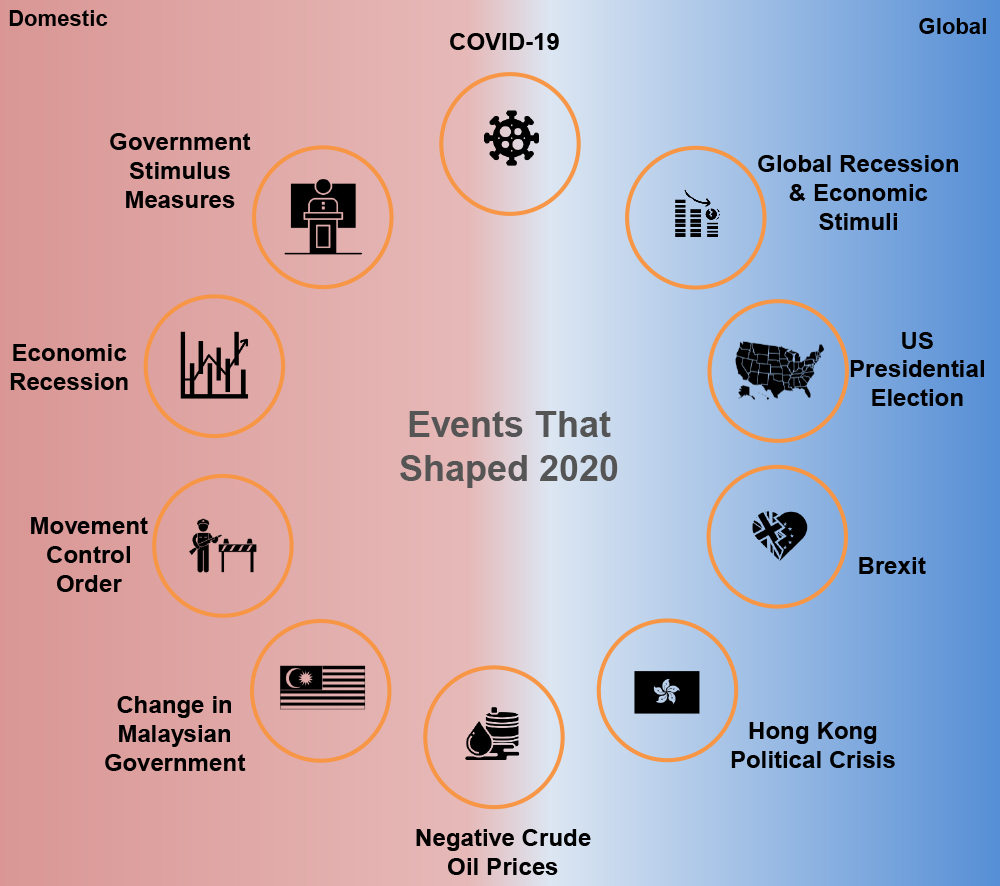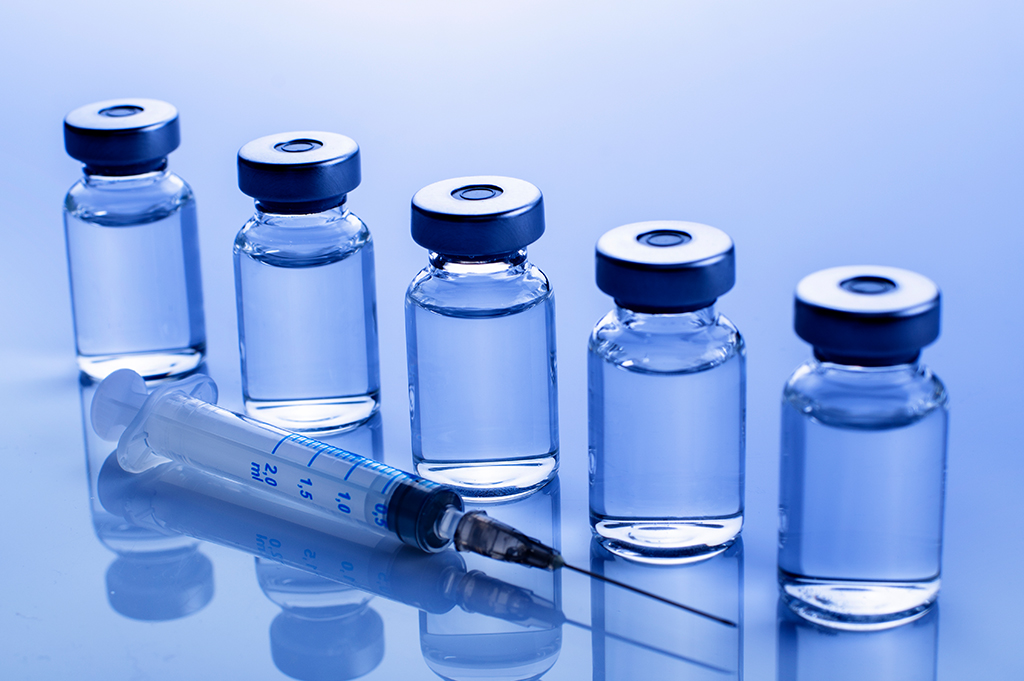KF Spotlight – Year 2020 in Review & Preview of Q1 2021

Prepared by Aron Liew, CFA and Zainal Aiman
2020 would definitely be a year that no one would ever forget on how the health crisis can cause a major impact to the world economy. Initially, the global financial market and economy began the year on a positive track with rising commodities’ prices and the conclusion of US-China Phase One Trade Deal. On top of that, factors in the end of 2019 such as US 50-year low unemployment rate, robust economic growth and the dovish monetary policies from the US Federal Reserve, were carried over into the early part of 2020. However, the narrative began to take a volatile turn as the year progresses.

COVID-19 Began To Cause A Ripple

COVID-19, which was first detected in the province of Wuhan of Mainland China in December 2019, has spread globally at an alarming speed, leading to the World Health Organization (WHO) to declare it as pandemic. As the number of infections rose across the world, movement controls and travel restrictions were widely implemented, affecting global economic activities. Global financial markets deteriorated significantly in March and April, and many nations recorded negative growth in their second quarter readings.
Imminent Global Recession
International Monetary Fund (IMF) on its latest World Economic Outlook in October 2020 predicted a deep global recession will happen in 2020 and world growth is projected to be at -4.4%. Meanwhile, World Bank expected a 5.2% contraction in global GDP in 2020, which will be the deepest global recession in decades. In line with the global economic contraction, the world’s largest economy, United States of America (USA), also suffered a huge contraction in its GDP in the second quarter of the year, having fallen at a rate of 31.4% on a year-on-year basis before rebounding in the third quarter at a 33.4% annualized rate.

US Presidential Election

One of the major highlights in 2020 was the 59th quadrennial United States presidential election that was held on 3 November 2020. This election saw a battle between incumbent President and Republican candidate, Donald Trump, and Democratic candidate, Joe Biden, where the outcome favoured Joe Biden with electoral votes of 306 to 232. The election also saw the largest total voter turnout in US history.
Official Withdrawal of UK from EU – Brexit
In January 2020, a historic event took place when the United Kingdom (UK) officially left the European Union (EU) after 47 years of membership. With the divorce, UK began an 11-month transition period and, at the end of this phase, UK will have a new relationship with EU. Officially, on 31 December 2020, UK completed its formal separation from the EU where the UK-EU trade agreement took effect. With this, UK now has its own rules and regulations on trade, travel, immigration and security cooperation.

Crude Oil Futures Recorded Historical Negative Prices

On commodity development, the benchmark West Texas Intermediate (WTI) crude oil prices recorded a negative price for the first time ever in history. The price of a barrel of WTI fell as low as negative USD37.63 per barrel on 20 April 2020, due to the unexpected price war between Saudi Arabia and Russia in early March after OPEC and its allies failed to reach a consensus on deeper supply cuts. Fortunately, OPEC and its allies agreed to go back to the negotiating table, agreeing to a production cut of 10 million barrels per day that lasted until June. Ever since then, prices had recovered and traded around USD40 per barrel range.
China’s Imposition of National Security Law in Hong Kong
On the regional front, a year after major protests, the political crisis in Hong Kong escalated into new heights when China decided to impose a sweeping national security law on Hong Kong. The move has prompted lot of criticism from Hong Kong political activists as well as international community including USA, who decided to remove Hong Kong’s special status under United States-Hong Kong Policy Act of 1992, as it seems to undermine the freedom enjoyed by the city under the “One Country, Two Systems” principle.

Change In Malaysia’s Political Landscape

Back at home, 2020 has been one of Malaysia’s most turbulent times in its history. On February 2020, Malaysia’s Pakatan Harapan (PH) coalition, which won the 14th general election in 2018, collapsed driven by a series of political upheavals. Following the resignation of previous Prime Minister Tun Mahathir Mohamad, Tan Sri Muhyiddin Yassin was appointed as the new Prime Minister under a new political coalition known as Perikatan Nasional (PN).
The Enforcement of Movement Control Orders
Just like many other countries in the world, Movement Control Order (MCO) was enforced nationwide from 18 March to curb the spread of the COVID-19 infections. Under this order, most business premises are required to shut down except for those in essential services. As situation improved, the country moved into Conditional Movement Control Order (CMCO) and later to the Recovery Movement Control Order (RMCO) where more sectors are allowed to reopen albeit international borders remain shut.

Economic Growth Affected and the Introduction of Series of Economic Measures

Malaysia’s Gross Domestic Product (GDP) contracted 17.1% year-on-year in Q2 2020, The contraction, the worst performance in nearly 22 years since the Asian financial crisis, was mainly due to the fallout of domestic spending and exports growth. GDP slowly recovered to a contraction of 2.7% in Q3. To mitigate the economic impact brought upon by the pandemic, Malaysia introduced several monetary and fiscal measures. On monetary stance, the central bank slashed the Overnight Policy Rate (OPR) four times this year by a cumulative 125bps reduction, making the latest rate to be at 1.75%. On fiscal measures, the government introduced several fiscal stimuli amounting to about RM 305 billion.
Source : The EdgeMarket, BBC News and The Star
Market Preview for Q1 2021
| Product |
2020 Review |
Q1 2021 Outlook |
|---|---|---|
|
Crude Palm Oil Futures Contract (FCPO) |
2020 Performance: 17.96% FCPO kick off the year relatively well amid the news of Malaysia government’s biodiesel mandate. However, prices plunged in March due to the impact of border shutdown amid COVID-19 pandemic to RM1,946/MT. Prices began to recover on demand recovery as economies were reopened, while the lower production, Malaysia’s government decision to slash export levy and higher competing oil prices had also supported the prices. |
Outlook : Positive Supply-demand dynamics are expected to remain tight while current low stockpiles may take time to recover as production numbers are expected to be challenged amid the tight labor supply, together with higher domestic consumption from both Malaysia and Indonesia via higher biodiesel mandates. |
|
FTSE Bursa Malaysia KLCI Futures (FKLI) |
2020 Performance : 2.51% FKLI plunged, in line with global indices, as investor sentiment were impacted by the pandemic, unstable local political scene and the volatile movement of crude oil prices. However, market regain its momentum in middle of the year, driven by bullish demand among glove makers and accommodative economic measures introduced by the new government. |
Outlook : Cautious Optimism on synchronized global economic recovery could trigger a return of foreign investor interest in emerging markets including Malaysia. Furthermore, we expect to see a gradual economic recovery while reflation could be on the cards. However, the outlook still remains to be cautious in the wake of COVID-19 vaccine deployment and political instability. |
Source : Bloomberg and The EdgeMarket
| Product |
2020 Review |
Q1 2021 Outlook |
|---|---|---|
|
Gold |
2020 Performance: 25.12% Gold prices thrived on uncertainties as it breached the USD2,000 level for the first time ever. Sentiment was buoyed by the economic uncertainty due to COVID-19 pandemic, the lower interest rate regime and a significant rise in debt amid the expansionary fiscal approach by many countries. However, prices retreated slightly in Q4 amid the news of COVID-19 vaccine development. |
Outlook : Mildly Positive The key factor that will determine gold performance in 2021 would be the containment of coronavirus. If the rollout is successful, we expect to see some cap on gold prices as investors are likely to shift back to equities or bonds. Nevertheless, inflationary pressures, deep fiscal deficit globally and a weaker US dollar might provide some upside. |
|
COMEX Copper Futures Contract |
2020 Performance : 25.81% Copper futures registered a significant growth in both trading volume and price in 2020. One of the key factors that contribute to this impressive performance is the sign of rapid economic revival of China, the world’s biggest importer of copper. Other than that, the disruption of supply in the world’s two largest copper producer; Chile and Peru had also boosted copper’s price higher. |
Outlook : Mildly Positive Prices are expected to be supported by a sustainable demand in 2021 due to the metal’s importance in economic activity and infrastructure development in major countries like China and India. This will further be supported by the global pursuit for a cleaner energy. However, any unfavourable containment of the COVID-19 situation may hinder the demand recovery. |
Source : Bloomberg ,The EdgeMarket and Investing.com
| Product |
2020 Review |
Q1 2021 Outlook |
|---|---|---|
|
Crude Oil Futures |
2020 Performance: Brent: -21.52%WTI: -20.54% Main highlight of 2020 would be the negative readings of WTI crude oil prices when Saudi Arabia launched a price war in April. Market further deteriorated due to disruption in energy demand brought about by COVID-19. Prices began to recover on demand recovery amid the reopening of economies and tracking the news of COVID-19 vaccine development and expectation of OPEC and its partners to delay the production increases. |
Outlook : Cautious A better price outlook is expected for crude oil in Q1 2021 mainly because of the restrained OPEC+ production. However, the outlook remain to be cautious as OPEC predicted the global oil demand will rebound more slowly in 2021 than previously thought due to the pandemic. The statement was supported by IHS Markit where according to the energy expert, the demand will likely to take another year or so to return to pre-pandemic levels. |
|
CBOT Soybean Oil Futures |
2020 Performance : Soybean Futures : 28.46%Soybean Oil Futures :25.63% US soybean prices were also badly affected by the pandemic in Q1 but regained its positive momentum afterwards as domestic demand for US meat processing industry increased and supply tightened amid dry weather in South America. |
Outlook : Positive US soybean is expected to see positive movements in 2021, taking cue from the growing optimism on higher export demand from China, tight ending stocks and rising domestic crushing. On the flip side, apart from COVID-19 uncertainty, the fate of the US-China trade deal remains unclear under the new presidential regime, who wish to revisit the agreement. |
Source : Bloomberg, The EdgeMarket, CME Group, IHS Markit and EIA
| Product |
2020 Review |
Q1 2021 Outlook |
|---|---|---|
|
US Dow Jones Average Index |
2020 Performance: 7.25% US stock markets, including US Dow Jones, began to enter the bear territory in February and March due to the pandemic effect. Market rebounded afterwards despite the continuous surge in COVID-19 cases in the country and the sign of economic severity. Among the factors that guided the recovery were the swift actions taken by US Federal Reserve, the government’s stimulus package and the news of vaccine development. |
Outlook : Cautious The volatility is likely to persist in 2021. Some catalysts that can spur the market are the arrival of COVID-19 vaccine in the early months of 2021 and the intention of Federal Reserve to keep interest rates low for the foreseeable future. However, lingering uncertainties surrounding the pace of economic recovery under the new President Joe Biden and the timing of another stimulus package from Congress might keep investors on the sidelines |
|
Hang Seng Index |
2020 Performance : -3.40% Market slumped in Q1 amid the impact of COVID-19 and rising political tension in the country which saw China imposing a national security law in the region. Market improve in second half of 2020, mainly driven by economic recovery in China and in response to massive stimulus package by Hong Kong government, while the decision of US to delist Chinese companies from their stock market had also spurred the interest to Hong Kong stock market. |
Outlook : Cautious Hong Kong’s GDP is expected to rebound this year, mainly spearheaded by gradual recovery in domestic demand and tracking the firmer growth in China. However, uncertainty over the political situation in the region as well as the course of the pandemic will continue to play into investor’s sentiment. |
Source : Bloomberg and The EdgeMarket
Download full article here
Disclaimer:
This document has been prepared solely for the use of the recipient. No part of this publication may be reproduced, stored in a retrieval system, or transmitted in any form or by any means without the prior written permission from Kenanga Futures Sdn Bhd. Although care has been taken to ensure the accuracy of the information contained herein, Kenanga Futures Sdn Bhd does not warrant or represent expressly or impliedly as to the accuracy or completeness of the information. This information does not constitute financial or trading advice; neither does it make any recommendation regarding product(s) mentioned herein. Kenanga Futures Sdn Bhd does not accept any liability for any trading and financial decisions of the reader or third party on the basis of this information. All applicable laws, rules, and regulations, from local and foreign authorities, must be adhered to when accessing and trading on the respective markets.

